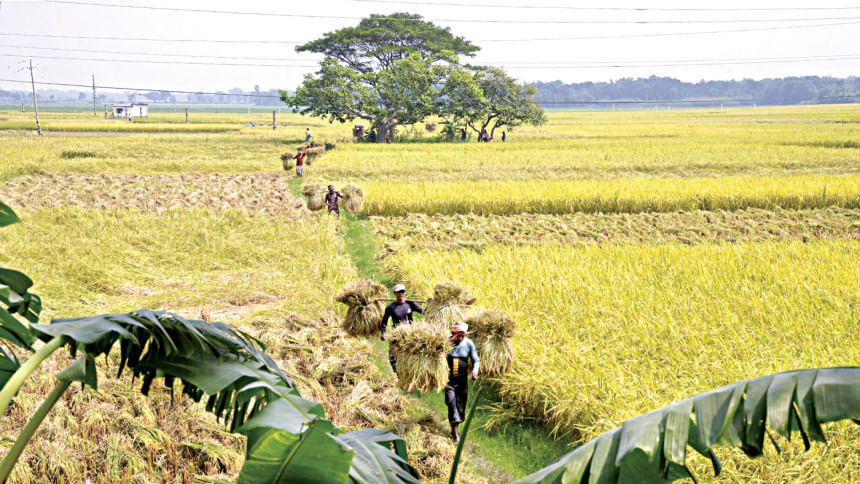Favourable weather, higher acreage boost Aman outlook

Farmers have started harvesting Aman season paddy in some northwestern regions amidst expectations of an increase in production, according to agricultural officials citing a year-on-year rise in acreage and favourable weather.Farmers transplanted the rain-fed crop on 59.28 lakh hectares of land, which was 6 percent higher year-on-year, according to a preliminary estimate by the Department of Agricultural Extension (DAE).Farmers and agriculturists said repeated floods and unfavourable weather aff...
Farmers have started harvesting Aman season paddy in some northwestern regions amidst expectations of an increase in production, according to agricultural officials citing a year-on-year rise in acreage and favourable weather.
Farmers transplanted the rain-fed crop on 59.28 lakh hectares of land, which was 6 percent higher year-on-year, according to a preliminary estimate by the Department of Agricultural Extension (DAE).
Farmers and agriculturists said repeated floods and unfavourable weather affected Aman season paddy last year.
Until now, there has been no major flood. Rather, regular rainfall supported the growth of the crop, they said.
"The crop condition looks excellent. We are expecting a good harvest this year," said DAE Director (Field Services Wing) Md Obaidur Rahman Mondol.
He said pest attacks could not affect the staple grain this season.
Aman rice accounts for 40 percent of the total annual rice crop, estimated at around 4 crore tonnes in the fiscal year 2024-25, and several farmers in the northwestern region expressed optimism regarding a good harvest.
The expectation comes at a time when rice is being sold at a higher price this year compared to previous years, despite imports and an increase in production.
Coarse rice, the benchmark grain for market price, was sold at Tk 55 to Tk 60 per kilogram at retail in Dhaka's markets yesterday, up 9.5 percent from a year ago, according to data compiled by the Trading Corporation of Bangladesh.
In its latest report, the Bangladesh Trade and Tariff Commission said an increase in production costs is a major reason behind the price spike. It added that prices declined in recent days because of imports.
"As there was no major flooding this year, the yield looks promising," said Abu Taleb, a grower at Char Gokunda on the Teesta river in Lalmonirhat sadar upazila.
Farmers have begun harvesting the crop grown on many char areas along 26 rivers, including the Brahmaputra, Teesta, Dharla, Dudhkumar, and Gangadhar, in the northwest.
The 65-year-old farmer planted Aman on five bighas of char land and started harvesting paddy on Sunday. He has not weighed it yet but expects around 20 to 21 maunds (one maund equals around 40 kilogrammes) of paddy per bigha.
Data from the DAE Rangpur region -- Lalmonirhat, Kurigram, Rangpur, Gaibandha and Nilphamari -- show that Aman paddy has been cultivated on 6.20 lakh hectares of land this season.
Of this, the crop has been grown on 30,000 hectares of land in nearly 600 riverine chars. Farmers in these areas usually grow early-maturing and flood-tolerant varieties.
In August this year, the US Department of Agriculture (USDA) projected a 4 percent increase in Aman cultivation area to 58 lakh hectares from the previous Aman season, alongside increased yields this year.
The US agency said many northern farmers began transplanting Aman saplings at the beginning of July. By the second week of August, more than 80 percent of the Aman sapling transplantation in this region was complete, it added.
"In contrast, farmers in the southern part of the country typically start transplanting Aman in early August and complete it by the end of the month. Some farmers in this region may continue transplanting into the first week of September," it said.
Hamidul Mondol, a farmer at Char Jatrapur in Kurigram sadar upazila on the banks of the Brahmaputra river, said the Aman crop remained unaffected as there was no major flood in the Brahmaputra basin this year.
"We usually grow early varieties so that we can plant winter crops soon after. My three bighas of Aman are ripe now, and I'll start harvesting within the next two to three days," he said.
Mohammad Khalequzzaman, director general of the Bangladesh Rice Research Institute, said last year, 11 lakh tonnes of rice were lost because of floods and inclement weather.
"The weather has been favourable so far this year. So, overall production is expected to be higher this year than the previous year. We saw rainfall when it was required for the crop. There has been no terminal drought," he said. The rainfall reduced the requirement for irrigation during the season.
The Bangladesh Bureau of Statistics (BBS) estimated Aman production at 1.65 crore tonnes in the Aman season in the fiscal year 2024-25, nearly one percent down from the previous year.
Sirajul Islam, additional director of the DAE in the Rangpur region, said harvesting of Aman paddy has already started in the char areas and will be completed this month.
"In mainland areas, the harvest will begin in the first week of November. Since flooding was less severe this year, the Aman yield in char lands is expected to be satisfactory. We are also expecting good output in the mainland fields."